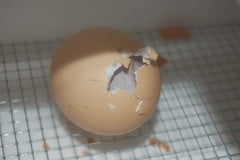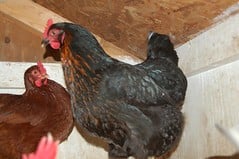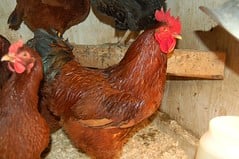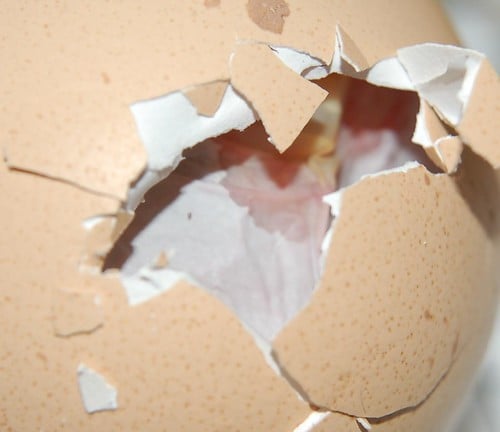I just made a terrible mistake. I started out with 22 eggs. I candled at 7 days like I read I should do with brown eggs. I couldn't tell anything. I tried again at 10 days and WOW! I removed 9 eggs that were obviously not making the same progress as the other 13. I candled again at 14 days and again the difference was obvious. One more gone. Now the trouble starts.
I'm still trying to figure out how to keep the humidity as high as I've heard recommended. I have a Little Giant still air incubator. I filled the grooves up with water and it doesn't even come close. I made three little pans out of aluminum foil and I was able to get it up to about 50%.
At day 20 I had a pip. I don't have to tell anyone who's hatched one chick how exciting that first one was. I was a little baffled though. A whole day early. BYC forum members let me know that was OK and I went to bed because I couldn't stay awake. I awoke to a new chick whose first action in life was to roll its brothers and sisters all over the place. Again BYC Forum to the rescue. I was assured they'd be fine. At 21 days almost to the hour, a second pip. 15 hours later I got to see one hatch. I even filmed it.
At 21 days 16 hours I noticed two more pipped. Again I had to go to bed. This morning 22 days now I was sure all was lost. I still hear chirping but I figured those that hadn't pipped were lost. I took one of the eggs out that hadn't pipped. It felt cold. I broke it open and found a dead deformed chick. I took another that hadn't pipped. It didn't feel cold. I broke it open on the air pocket end and to my horror I could see the chick moving inside. I put it back in the incubator and I'm hoping it will make it so I don't have to be sick about it for weeks.
The moral of my story: Patience is a virtue. (Not an original thought by the way, just my own application) If your chicks are dead at day 22, they'll still be dead at day 25. Give them a chance. This is my first time hatching and I would really appreciate it if someone will correct me if this is bad advice.
Thanks so much to all of you who post here. My failures I take the blame for. That I've had any success at all I owe to you.
I'm still trying to figure out how to keep the humidity as high as I've heard recommended. I have a Little Giant still air incubator. I filled the grooves up with water and it doesn't even come close. I made three little pans out of aluminum foil and I was able to get it up to about 50%.
At day 20 I had a pip. I don't have to tell anyone who's hatched one chick how exciting that first one was. I was a little baffled though. A whole day early. BYC forum members let me know that was OK and I went to bed because I couldn't stay awake. I awoke to a new chick whose first action in life was to roll its brothers and sisters all over the place. Again BYC Forum to the rescue. I was assured they'd be fine. At 21 days almost to the hour, a second pip. 15 hours later I got to see one hatch. I even filmed it.
At 21 days 16 hours I noticed two more pipped. Again I had to go to bed. This morning 22 days now I was sure all was lost. I still hear chirping but I figured those that hadn't pipped were lost. I took one of the eggs out that hadn't pipped. It felt cold. I broke it open and found a dead deformed chick. I took another that hadn't pipped. It didn't feel cold. I broke it open on the air pocket end and to my horror I could see the chick moving inside. I put it back in the incubator and I'm hoping it will make it so I don't have to be sick about it for weeks.
The moral of my story: Patience is a virtue. (Not an original thought by the way, just my own application) If your chicks are dead at day 22, they'll still be dead at day 25. Give them a chance. This is my first time hatching and I would really appreciate it if someone will correct me if this is bad advice.
Thanks so much to all of you who post here. My failures I take the blame for. That I've had any success at all I owe to you.
Last edited:








